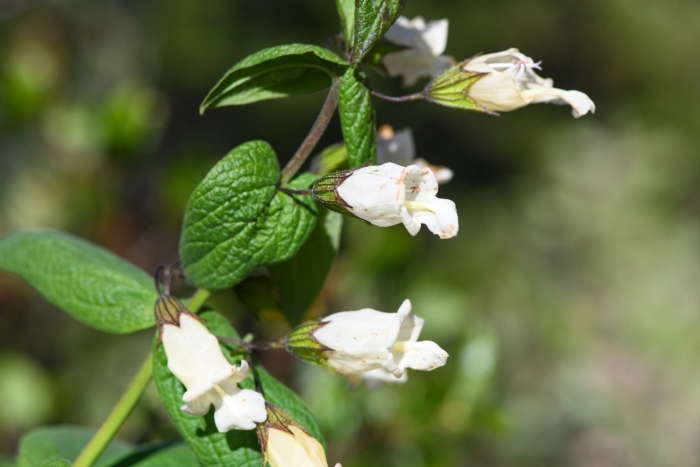Santa Ana Pitcher Sage
(Lepechinia cardiophylla)
Santa Ana Pitcher Sage (Lepechinia cardiophylla)
/
/

© Chloe and Trevor Van Loon
CC BY 4.0
Image By:
© Chloe and Trevor Van Loon
Recorded By:
Copyright:
CC BY 4.0
Copyright Notice:
Photo by: © Chloe and Trevor Van Loon | License Type: CC BY 4.0 | License URL: http://creativecommons.org/licenses/by/4.0/ | Uploader: chloe_and_trevor | Publisher: iNaturalist |

























Estimated Native Range
Summary
Lepechinia cardiophylla, commonly known as Santa Ana pitcher sage, is a fragrant, semi-deciduous shrub native to the chaparral and coastal sage scrub of Southern California, including the Peninsular Ranges, Santa Ana Mountains, parts of San Diego County, and extending into northern Baja California. It typically grows to a height of 3-6 feet (0.9-1.8 meters) with a similar spread. Santa Ana pitcher sage has a distinctive appearance with heart-shaped, aromatic leaves and tubular flowers that range from white to lavender, blooming from late spring to early summer. The flowers are attractive to pollinators such as hummingbirds and bees.
Santa Ana pitcher sage is valued for its fragrant foliage and attractive flowers, making it a desirable addition to native plant gardens, wildlife gardens, and as a component of xeriscaping. It is drought-tolerant once established, requiring minimal supplemental water, and prefers well-drained soils with low to moderate fertility. It thrives in full sun to part shade conditions. While not commonly available in the nursery trade, it can be propagated from cuttings or seeds. Potential problems include root rot in poorly drained soils and damage from browsing by deer. Gardeners should be aware of its limited distribution and conservation status when considering this plant for cultivation.CC BY-SA 4.0
Santa Ana pitcher sage is valued for its fragrant foliage and attractive flowers, making it a desirable addition to native plant gardens, wildlife gardens, and as a component of xeriscaping. It is drought-tolerant once established, requiring minimal supplemental water, and prefers well-drained soils with low to moderate fertility. It thrives in full sun to part shade conditions. While not commonly available in the nursery trade, it can be propagated from cuttings or seeds. Potential problems include root rot in poorly drained soils and damage from browsing by deer. Gardeners should be aware of its limited distribution and conservation status when considering this plant for cultivation.CC BY-SA 4.0
Plant Description
- Plant Type: Shrub
- Height: 2-3 feet
- Width: 2-3 feet
- Growth Rate: Moderate
- Flower Color: Purple, White
- Flowering Season: Spring, Summer
- Leaf Retention: Deciduous
Growth Requirements
- Sun: Full Sun
- Water: Low
- Drainage: Fast
Common Uses
Bird Garden, Drought Tolerant, Hummingbird Garden, Low Maintenance
Natural Habitat
Chaparral and coastal sage scrub of Southern California, including the Peninsular Ranges, Santa Ana Mountains, parts of San Diego County, and northern Baja California
Other Names
Common Names: Heartleaf Pitcher Sage, Heart-Leaved Pitcher-Sage, Cardoncillo
Scientific Names: , Lepechinia cardiophylla,
GBIF Accepted Name: